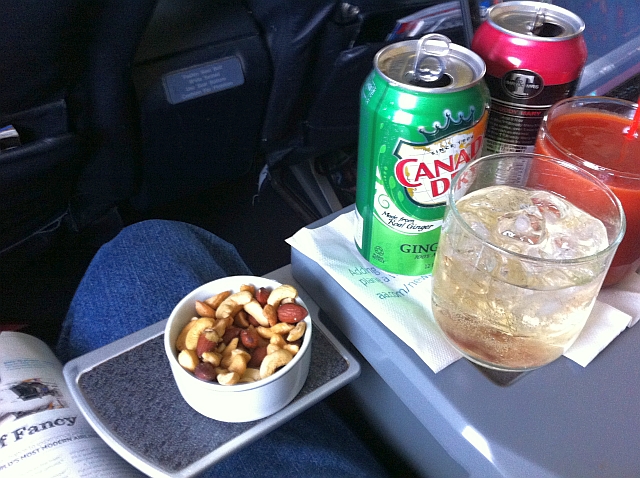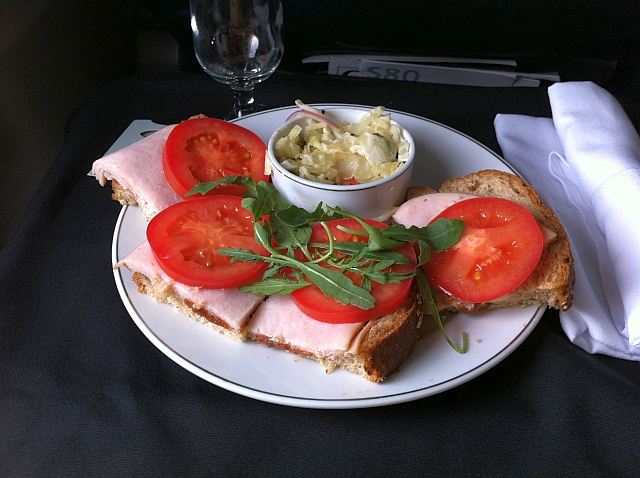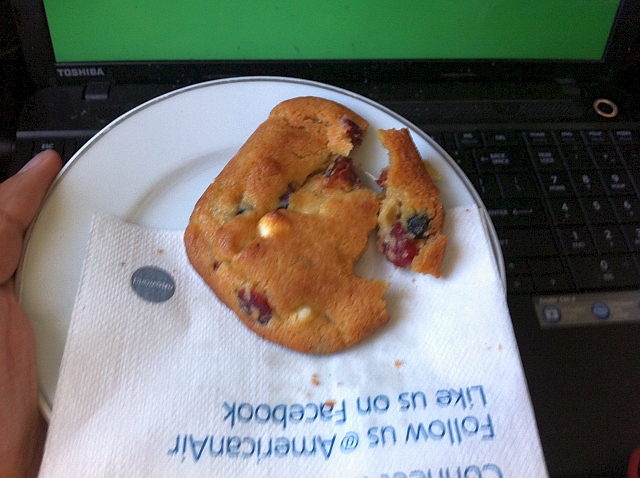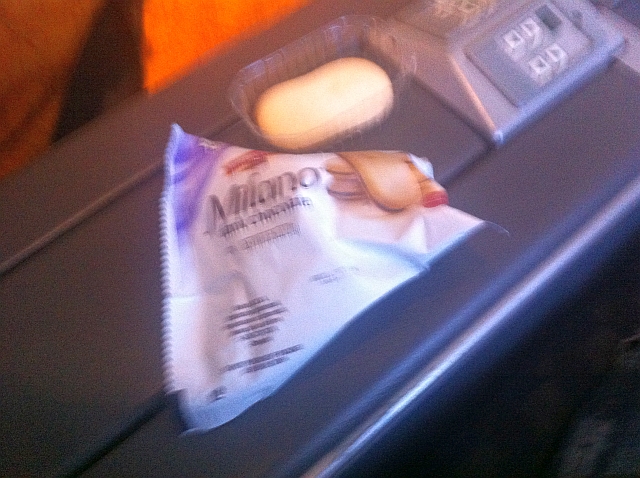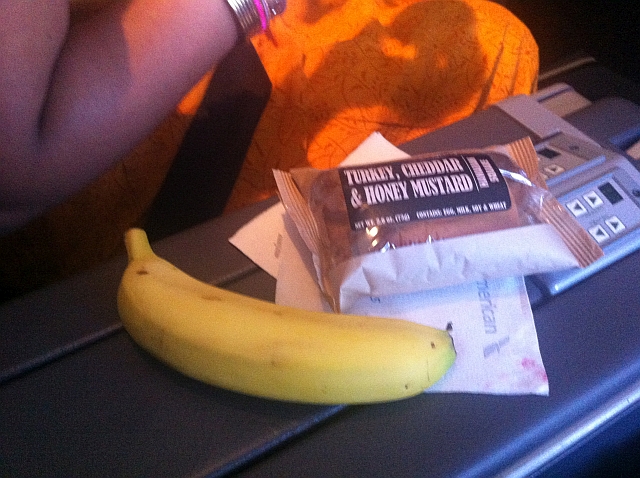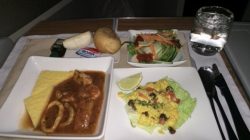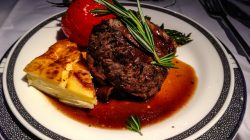This past holiday weekend, I flew to Orlando and back to visit family in AA First. I’ll have a full trip report up soon, but I did want to report on one thing immediately. I had the opportunity to compare and contrast AA’s old meal service on the Florida inbound to the new, “enhanced” service on the Florida outbound. Several bloggers and travel websites have covered the impending change, and fellow UPGRDr Rocky posted an excellent analysis of the new vs. old AA First Class meal policy back in early August. So what’s the verdict? Unfortunately, early returns indicate, as Harry Potter fans will appreciate, that this change clocks in with the infamous “D” for “Dreadful”.
So How Did We Get Here?
The impetus for the change in meal policy is actually fairly simple – merger partners US Airways and American Airlines had two fundamentally different approaches to in-flight meals in premium class. Prior to the change, US Airways only provided meals on flights greater than 3 hours and 45 minutes in length. AA, on the other hand, provided full meals for any flight 2 hours (approx. 700 miles) or greater in length. A new standardized policy needed to be implemented across both airlines. There was also some need to simplify the AA meal chart a bit. Rocky’s post above includes a chart illustrating the old policy, which was a mish-mash of snack, lunch, “basic dinner”, and “dinner plus” depending on the specific time and length of your flight. Further confusing matters, what is listed as a “snack” most often ended up being a complete meal, just with a cold entrée instead of a hot one.
Ultimately, AA basically split the difference between policies, cutting meal service to a snack basket for flights between 2 hours and 2 hours 45 minutes. At the same time, though, snack baskets are now provided for flights under 2 hours, and US Airways flights gain varying degrees of meal service for previously meal-less flights under 3 hours 30 minutes. On paper, the new system is simplified, with a 5-tier system based solely on flight length. In practice, it’s not really any different than the old system, except the mid-day “snack” has now been properly classified as a “3-course meal”. In addition, exceptions to the general rules still abound, such as the retention of full meal service on shorter, high business travel routes like DFW to Chicago O’Hare.
The Old System
Our flight out on Saturday the 30th to MCO was under the old system, and labeled as a “snack” on our boarding passes. It was, in fact, your standard 3-course mid-day meal, consisting of warm mixed nuts, cold entrée (in this case, a turkey sandwich), and a fresh baked cookie.
This was a pretty typical AA domestic F meal in my experience. AA’s meals weren’t going to win any culinary awards and I probably wouldn’t pay for this if it were for sale – the sandwich was a bit soggy, and the cookie, while tasty, wasn’t cooked all the way through – but it was adequately tasty, and satisfying enough that we could hit the road immediately for our 3 1/2 hour drive from Orlando without worrying about stopping for lunch on the way. It was also enough to make you feel like you got just a little something extra for spending the money to upgrade to first, aside from a little extra legroom and an alcoholic drink or two.
The New System
Our return flight from MCO was on Monday the 1st, which coincidentally was also the first day that the new standardized US/AA meal service was scheduled to go into effect. I actually bought our tickets before the change was announced, so the meal code for our flight changed from “dinner” to “refreshments” after the announcement. AA’s official description of what’s provided for flights between 2 hours and 2 hours 45 minutes is “a heartier selection of snacks such as sandwiches and fresh fruit is served on most flights”. On this flight, this meant a basket containing:
- Plain potato chips
- A package of 2 Pepperidge Farm Milano cookies
- A pre-packaged turkey, cheddar, and honey mustard “sandwich”
- Apples
- Bananas
If you need a visual, here it is (apologies for the blurry image of the cookie wrapper).
First impression: what a bunch of cheapskates for passing this off as a First Class meal. But besides the undeniably cheap feeling conveyed by a bunch of pre-packaged supermarket snacks, there are several issues I have with the offerings. First, the “sandwich” is not an acceptable offering at all – barely the size of a roll, and it tasted like something that came out of an airport vending machine. Actually, I’ve probably had better from vending machines. Second, aside from the fruit (the banana was tasty at least), there are zero healthy offerings at all. I’m not in college anymore, and I just can’t do potato chips and cookies for dinner these days without feeling the effects later. And worst of all, no more mixed nuts! Those have long been my favorite part of flying AA First (yeah, I know, I should probably get out more). We arrived home a little before 8, and I was both hungry and irritated that I’d now have to find something to cook at home after a long weekend of traveling.
The downgrades apply even to flights longer than the meal cut-off, as Rocky experienced with the New American meal service flying from St. Maarten to Miami. Gone is the fresh baked cookie, replaced with – you guessed it – the pre-packaged variety, and the little miniature wine glasses have been replaced with regulaer drink glasses. Call me snobbish, but it’s a little weird drinking wine from a glass that also doubles as a receptacle for a Jack and Coke.
AA Underestimates Value of In-Flight Meals, and Misses Opportunities to Boot
It’s been argued in some corners that the meal downgrade is no great shakes, as very few people base flight decisions on in-flight meals. Brett Snyder, aka the Cranky Flier, advocated this exact point of view in a recent post. Going in, I would have tended to agree with this view, but after reviewing comments on the issue on a variety of blogs, and experiencing the change myself, I’ve come to the concusion that AA is making a mistake here, and is perhaps underestimating the role that premium cabin meals play in the overall domestic First value proposition. While it’s true that few people probably book flights solely based on meal service, I do have to admit, during my heavy business travel days, I’d hope for an upgrade, especially on an early morning or evening flight, because the meal that came with the upgrade would mean a) an extra 15 minutes to sleep in since I wouldn’t have to worry about picking up breakfast at the airport, or b) being able to squeeze a few more minutes of time at the client and then head straight home after landing without worrying about picking up dinner on the way. Judging by the comments I’ve seen on other sites, other frequent business travelers see real value in in-flight meals for much the same reason – and that’s a demographic you really don’t want to annoy if you’re an airline.
But perhaps even more than that, AA seems to have missed a real opportunity to differentiate itself here by providing poor quality, cheap snacks. If the idea was to reduce costs and simplify, AA could have partnered with, say, DFW-based Zoes Kitchen to design snack baskets for shorter flights. Pita chips with a little tub of hummus comes to mind. I’m sure Zoes wouldn’t mind the free advertising, and to me at least, this would come off as innovative, especially since it would be a partnership with a hometown company. And it could still be done pre-packaged, allowing AA to achieve the objective of cutting costs. Instead, the whole change, at least from the perspective of AA fliers, comes off as the New American going cheap on the premium cabin amenities. Which brings us to the broader issue, I think…
New American Management Has a Perception Problem, and This Doesn’t Help
I’ve seen a fair amount of trepidation about the US Airways/American merger, even while the tie-up was in the rumor stage, among AA loyalists. I’d count myself in this category as well. Much of this is due to a distrust of new CEO Doug Parker and his management team; fair or not, his reputation among many AA fliers is one of a ruthless penny-pincher who will look for any way to save a buck, even if it means ticking off elites. Some of his gambits at US, such as selling elite status on the cheap, and the ill-fated attempt to introduce soda fees on domestic flights, didn’t help in that regard. The fear among many was that Parker would do to AA what he’d done to US Airways – turn the airline into essentially a glorified low-cost carrier, cutting frills but charging legacy carrier prices and providing the usual surly legacy carrier service. And in fact, the early merger changes are doing very little to assuage the distrust that Parker is a leopard that hasn’t changed its spots – first through the sale of cheap First Class upgrades on the day of travel at the expense of elite upgrades, then the devaluation of the AAdvantage award chart with no advance notice, and now the devaluation of premium cabin meal service.
AA management may be viewing this through the lens of well, we had to merge the programs so we just decided to split the difference. And it is true that for US Airways fliers, the new meal policy is an improvement, given that the previous meal service was a big bag of nothing. But Parker & Company should realize that the AA contingent of fliers is much larger than the US contingent, and based on AA’s Twitter feed and some grumbling I heard on my flight yesterday, the AA folks aren’t happy about the change. The powers that be should really tread carefully on trying to save a buck at every turn, lest the irritation grow sufficiently from a thousand little cuts here and there that business travelers will start considering other carriers.
As it is, I don’t fly much anymore, but when I do, I definitely won’t waste my money on an upgrade to AA First, at least on a flight under 1,000 miles. I’d frankly be better off paying for Main Cabin Extra and grabbing a crappy Value Meal at McDonald’s before going to the gate. At least I’ll arrive at my destination full, I’ll still have the extra legroom, and I’ll have the extra pocket money to do something else with.


